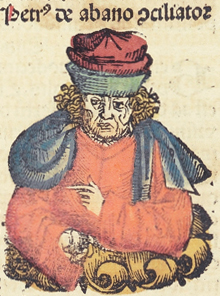Heptameron
The Heptameron, also called Magical Elements, is a grimoire of magic rites concerned with conjuring specific angels for the seven days of the week. Although written anonymously, authorship is frequently attributed to Peter of Abano, although most scholars agree it was not actually written by him. The book was likely written in the 1600s.
Author
The grimoire's supposed author, Peter of Abano (Pietro d'Abano), was an Italian physician who practiced various forms of medicine, astrology, and other occult arts. He lived in Greece for a period of time before commencing his studies at Constantinople between 1270 and 1290. Around 1300 he moved to Paris, where he was promoted to the degrees of doctor in philosophy and medicine, in the practice of which he was very successful, but his fees were remarkably high. In Paris he became known as "the Great Lombard."
He settled at Padua, where he gained a reputation as a physician. In Padua, he was charged with practising magic. Specifically, it was said he brought back into his purse, by the aid of the Devil, all the money he paid away, and that he possessed the philosopher's stone.
He was imprisoned by the Inquisition on charges of heresy and atheism in 1315. He died in prison while awaiting trial.
Content
The grimoire is a composite work containing ritual magic that provides a means for finding treasure, procuring love, detecting secrets, opening locks, and controlling or influencing the thoughts of others. Nearly all of the general magical text can also be found in various editions of the Lesser Key of Solomon.
The Heptameron is divided into two parts:
- Evocation of Demons, called spirits of the air.
- Evocation of Angels ruling over the days of the week.
It provides one section of spells and evocations for each day of the week as well as sigils to evoke the spirits who rule over those days.
